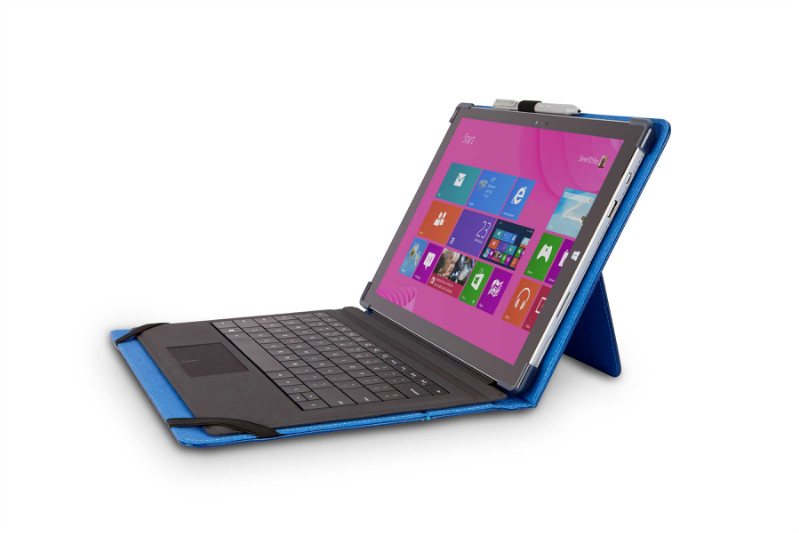On the road with my Surface Pro 3

It's been a summer of travel, one that also marks a year of using a Surface Pro 3 as my main travel machine. While I'm in my home office for a while it's a good point for me to empty out my travel bags and look at what hardware's worked for me while on the road.
One key piece of equipment is a good case, and I've ended up switching between two different Surface Pro cases, both from Maroo. Part of the Made for Surface program, Maroo's cases are solid and well-designed, with the cobalt blue leather folio my day-to-day case. While it offers extra shock protection and a good elastic pen loop, it's got an extra benefit in the way its keyboard cover folds back and over the knee. That gives you an extra surface for the case's kickstand, making a Surface Pro a lot more lappable - something that's useful in the cramped seats of a transatlantic or a cross-continental flight.

My one quibble with the Maroo folio is that it's quite hard to get the Surface Pro in and out of the case, as the corner bumpers are a tight fit. You certainly want a good grip, but until I found a trick involving the cutout on the top left bumper, it was a trial of strength that the case often won. All I can say, it's a good job I keep my thumb nails short!
The other case I use is their Woodland Sleeve, which is my usual "going through airport security" case. It's light, has a pocket for a pen, and also fits other devices like my MacBook Air, if I need to be carrying more than one machine on a trip. I can also use it as a lap stand, though it's not as comfortable as the folio case.
There's more to my travel bag than a Surface case though. Open the old laptop case I use to carry all my kit, and you'll see a selection of little zip bags. There's one for USB cables for charging devices, one for chargers, and one with an assortment of USB devices.
Chargerwise I've been using Anker's 5-port 40W smart USB charger for a while. However, it's now been replaced by a larger new version, the PowerPort 6, a 6-port 60W charger that has the same smart charging feature as the earlier model - meaning I can use it to charge two tablets, a trio of smartphones, and my Microsoft Band. It's certainly enough to fill a motel nightstand! Roughly the size of a pack of cards, it also means that one charger takes a lot less space in my bag, and I don't have to worry about finding outlets in a hotel room - leaving space to plug in my wireless router or a laptop charger.
With both Anker chargers fitting snuggly into one small bag, the only other charger I need to carry is the one for my camera. Now all I need to do is find a USB Nikon charger.
While I've bought car chargers and battery adapters for the Surface Pro 3 from Chinese vendors on Amazon, I'm reluctant to recommend any of them. They don't cost much, and you can tell quickly just why. They're flimsy and fragile, and as they usually don't have magnets in their connectors, they also often fall out of the Surface. At least I'm been able to repurpose the Anker Astro Pro 20000 mAh battery I tried out with the Surface Pro 3 as an extra power source for a review Surface 3.
Power isn't the only thing I need on the road, though it's certainly important. Connectivity is key to being able to work on the road, whether you're in a coffee shop, a hotel room, or a conference session, or just a friend's spare room for a night or two. And while wi-fi is great, it's not always available or reliable (especially if you're trying to file copy in a keynote hall with 25,000 people trying to use the same limited wi-fi bandwidth).
Luckily the Surface Pro has a single USB 3.0 port, so I can plug in a USB 3.0 gigabit Ethernet adapter, and I usually carry a couple in case I need to lend one to a colleague who's forgotten theirs (after all, they usually work with MacBook Airs as well as Surfaces). Of course that does mean I lose access to that USB port, so I've recently standardized on a useful USB 3.0 adapter from Inateck that also includes three USB 3.0 ports, so I can be checking the contents of a USB stick or taking images off a camera while I'm online.
And if I need more USB ports they offer a similar device that drops the Ethernet adapter in favor of an extra USB 3.0 port. Both devices are slim and light, and together don't take up much space in my kit bag. They've got a longer cable than some of their competitors, which makes them more suited for use with a Surface Pro 3, as its USB port is high on the side of the screen.
For the frequent traveler, there's lots of advantage in current trends in PC design. They're lighter, more resilient, and more powerful. Where I used to only carry one, fairly hefty and relatively low-powered laptop, I can now take two and still have space to spare for a small tablet. The same goes for power supplies, and as they shrink, my bags get smaller and lighter. All in all, a good thing.
Further reading
- The only computer that really matters: The cloud
- Developers, developers, developers: For Microsoft the tune might change but the words remain the same
- Re-evaluating Steve Ballmer: Satya Nadella isn't the only reason Microsoft is cool again
- Little computers, everywhere: Makers and the Internet of Things
- SQL, NoSQL? What's the difference these days?